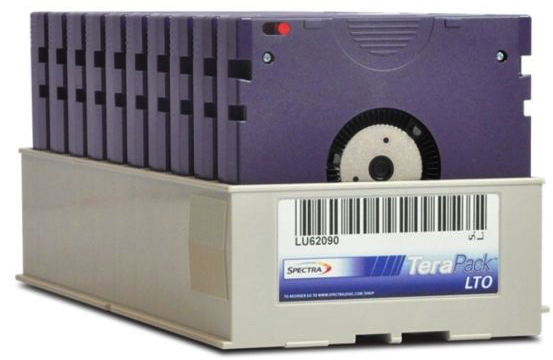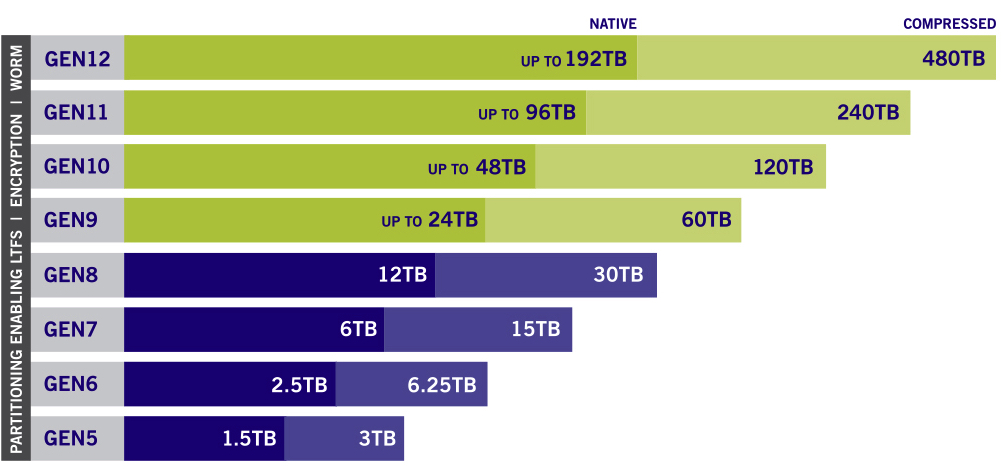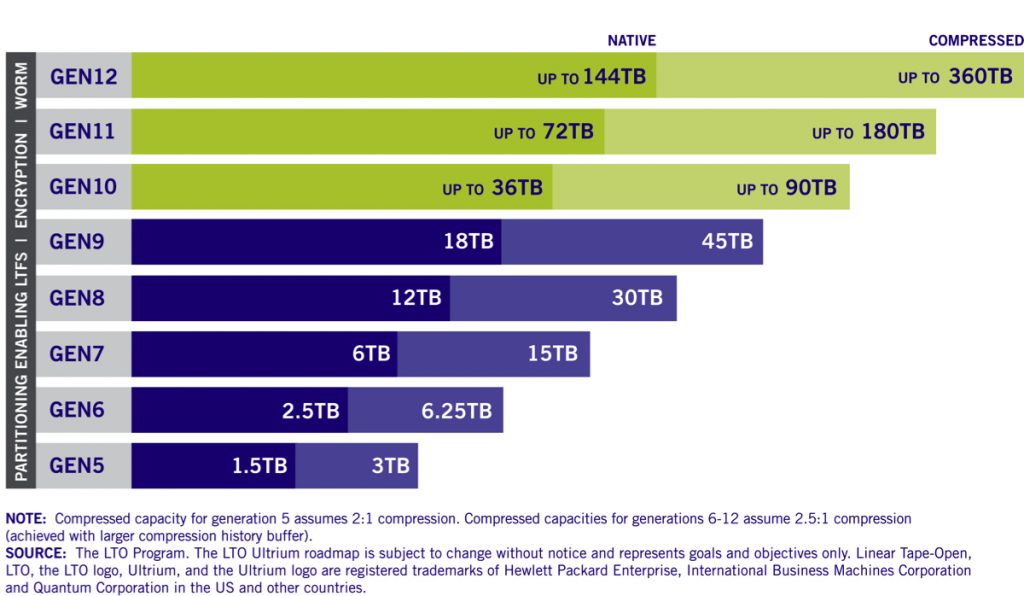LTO-9 Arriving as Specs Available
Capacity at 18TB native and 45TB compressed, less than former expectations, as usual
This is a Press Release edited by StorageNewsletter.com on September 10, 2020 at 2:15 pmThe LTO Program technology provider companies, Hewlett Packard Enterprise, IBM Corp. and Quantum Corp., announced the specs of LTO Ultrium format gen 9 (LTO-9), which are now available for licensing.

They are designed to increase tape cartridge capacity from the previous gen, with capacities of up to 45TB per cartridge when compressed.
They include previously introduced features, such as multi-layer security support via hardware-based encryption, WORM functionality and support for LTFS. They include backward read and write compatibility with LTO-8 cartridges.
These features help LTO tape maintain its position of a powerful, scalable, and adaptable open tape storage format that can provide more confidence for safe and secured offline storage, particularly in helping to prevent the impact of increasing cyberattacks. Offline storage – which creates an inherent “air-gap” that protects data from online predators – helps mitigate increasingly ransomware and malware threats that may corrupt live, backup, and archive data.
LTO media has doubled in capacity approximately every 2/3 years since the first gen launched 20 years ago. For LTO-9, the LTO Program elected to balance the cost and benefit of technology within the spec offering a 18TB tape cartridge – a 50% increase in capacity from the previous gen – to address the current market for storage space. A new roadmap has been established with the goal to double capacity in each gen moving forward.
“We are very excited at the future for LTO technology, and with increased capacity we are catering to the current and future market requirements for storage“, said Chris Powers, VP of collaborative platforms development and big data, HPE. “We continue to improve the core technology every gen, as tape is one of the most reliable and cost-effective storage solutions to retain data while keeping it safe from ransomware and other cyber-attacks.“.
In experiments in the IBM Research Zurich Lab, researchers have achieved 330TB of uncompressed data on a palm-sized tape cartridge – a record volume that is equivalent to about 330 million books.
According to the INSIC tape technology roadmap, the potential for tape technology to meet robust capacity predictions over the next decade shows a clear advantage to HDD technologies
Current LTO and enterprise tape drives operate at areal densities that are about 2 orders of magnitude less than the latest HDD. That means it is possible to continue increasing capacity of tape technology at historical rates for at least the next decade.
For instance, recent 18TB disk product must use 1,022Gb/in² vs. the latest 18TB LTO-9 cartridge that only uses 12Gb/in². That means that LTO-9 tape can achieve the same capacity with only 1/85th of the areal density than that of same capacity disk. Tape has much more recording area compared to disk and will be able to expand further in the years to come, according to INSIC. The combination of tape area and the ability to increase areal densities is the main reason why tape will continue to enjoy the 40%/year capacity growth.
“Given its long history of use and a solid path for future innovation, tape still has a significant role to play in the modern data center and in hybrid topologies,” says Christophe Bertrand, senior analyst, ESG. “Tape’s role is shifting, which further enhances its value. Other than archiving massive data sets for active archives or longer retention at low cost, tape has the ability to create an isolated and “air-gapped” layer. This emerging use case is perfect for keeping data out of reach of cyber-attackers.”
The latest gen of LTO tape technology, LTO-8, supports tape cartridge storage compressed capacity of up to 30TB.
Comments
After LTO-8, there will be LTO-9 even if this tape market is not booming, and maybe LTO-10 in the next 2 to 3 years.
For LTO-9, capacity will be 18TB native and 45TB compressed per cartridge, native 400MB/s and compressed 1,000MB/s transfer rate, assuming 2.5:1 compression available since LTO-6, with backward read and write compatibility with previous generation as usual, here LTO-8 cartridges. From LTO-9, it's a 50% increase in capacity from LTO-8 (12TB native, 30TB compressed) and improvement of 33% of transfer rate.
The specs are a little better on IBM TS1160, for high-end computing only, with proprietary cartridges of native 20TB (compressed 60TB) and 400MB/s (900MB/s compressed). On its side, Oracle/StorageTek discontinued its T1000 tape technology.
18TB native is exactly the capacity of the highest HDD on the market.
Up to now, LTO leader IBM and HPE has not announced any specific products with LTO-9. But it will happen. Furthermore, no prices have been revealed for the cartridges and the drives to be compared with the cost of former generation..
"Modern tape is nothing like tape of the past. The arrival of many rich tape technology improvements such as LTO-9 sets the stage for tape to be the most cost-effective storage solution for the enormous high capacity and archival challenges that lie ahead," noted Fred Moore, president, Horison Information Strategies. "Tape momentum should increase as data growth continues on an explosive path across many new applications and workloads, and in most of the largest hyperscale data centers."
Spectra Logic and Quantum already embraced of LTO-9 in their libraries, this later for Scalar i6000 and also StorNext AEL for archiving to be available next December.
It's not the first time that the specs finally announced for LTO are not on par with what was previously expected.
In LTO roadmap published at the same time as this press release on the LTO Program web site, LTO-9 is supposed to be native 24TB or 60TB compressed:

In the press release, the LTO Program states: "A new roadmap has been established with the goal to double capacity in each gen moving forward."
Here is the new roadmap published later:

It means LTO-10 will be at native 36TB but the figure is 48TB native in the official roadmap above.
LTO is supposed to be an open standard but currently there are limited sources: IBM seems to be the only manufacturer of drives for all the vendors, and Fujifilm and Sony for cartridges.
Read also:
LTO-9 Expected to Ship in Fall 2020
Revealed Spectra Logic.
by Jean Jacques Maleval | April 10, 2020 | News













 Subscribe to our free daily newsletter
Subscribe to our free daily newsletter


